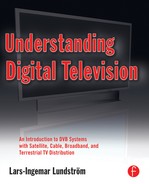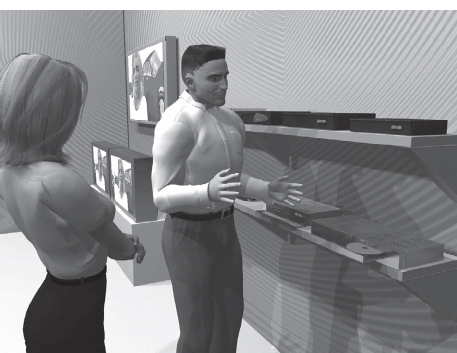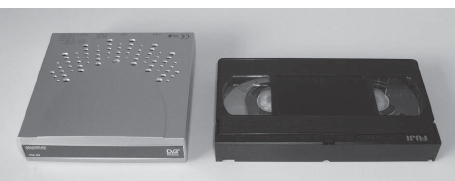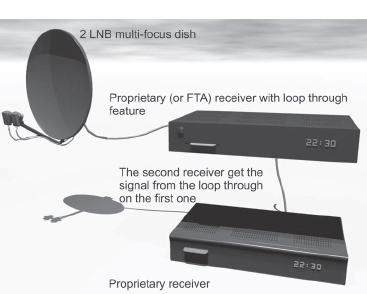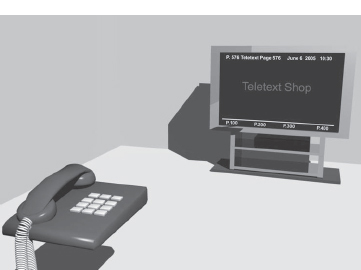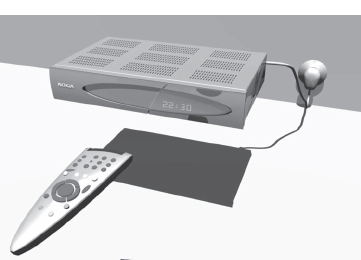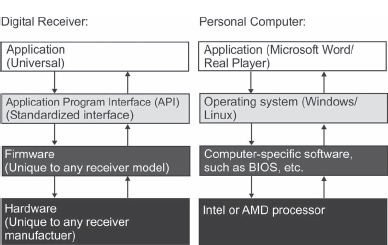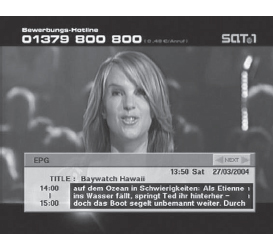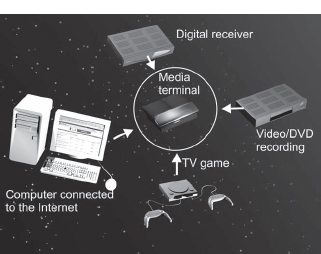8 |
Choosing the Right Box |
| CHAPTER |
FIGURE
8.1
Consumers can choose from a wide range of boxes for digital reception.
In this book, I have described how different kinds of digital TV work. There are four different kinds of set-top boxes: satellite, cable, terrestrial and IPTV. In addition, computers can be used for receiving TV, primarily via the Internet.
DIGITAL RECEIVERS
However, there are also other dimensions in digital TV. The basic principles for satellite, cable and terrestrial STBs are quite alike. But there are other differences. Digital technology also gives us options for lots of new features at different levels. There are digital receivers ranging from very simple featureless boxes to advanced media gateways equipped with hard discs.
Free to Air
The simplest receiver is the FTA, free to air, STB, like the one in Figure 8.2. It can only be used to receive unencrypted signals. In many European countries, such as Germany and Italy, and for terrestrial reception in the United Kingdom, this is enough for many people. If you have a multi-focus satellite dish, there are hundreds of unencrypted channels to watch for free.
FIGURE
8.2
There are lots of small and low cost STBs, including the German Maximum FTA 100. This receiver is smaller than a VHS cassette.
Pay TV
In recent years, pay TV has become more popular and people are quite interested in more specialized channels. But in most European countries, the state owned public service channels still hold a strong position along with the basic commercial general entertainment channels. Still, there is a lot of money to be made from direct payment from the viewers.
Pay TV is based on encrypting the channels and the viewer will need a receiver capable of decrypting the signals. In addition, most encryption systems require a smart card with keys and subscription information. The pay TV business is based on people buying or renting these cards. In certain cases, even commercial and public service channels are encrypted to avoid copyright problems when signals cross a country border, which often is the case in Europe. This problem especially applies to the Netherlands and Scandinavian countries where movies are broadcast in their original language with subtitles. In Germany, France and Italy, most movies are dubbed and this is considered as a kind of “encryption,” ensuring that a certain movie is only of use in a certain country.
However, encrypting pay TV channels is not that easy. There are a number of encryption systems available, and the pay TV operators have not selected or wanted to select one common standard for this. The most common systems in Europe are Irdeto, Nagravision, Viaccess, Mediaguard, Cryptoworks, Betacrypt and NDS/Videoguard. There are some other smaller systems, such as Conax as well. All these systems have evolved through several versions in their struggle against pirates. These systems are used in satellite as well as cable and for terrestrial transmissions.
Common Interface
In all this mess, there is something common to at least some of the systems—the “common interface,” where it is possible to put a common interface module for a certain encryption system into a common receiver.
Among the advantages of using CA (conditional access) modules is that the same receiver can be sold in many markets, bringing up volumes and lowering prices. Another idea is that it would be easy to exchange encryption system if it has been cracked by pirates. The CA system is put into a PCMCIA module and the receiver has a PCMCIA slot. In the module there is a card reader for the smart card, as shown in Figure 8.3.
When buying a receiver, it could be wise to buy a device that might be equipped with a CA module in the future. This especially applies to more expensive devices that might have hard discs and so on. However some of the systems, such as NDS/Videoguard, are not compatible with CA modules. Instead these systems are embedded in the receivers and the receiver has an internal card reader.
FIGURE
8.3
FTA receiver with two common interface slots for CA modules.
Figure 8.4 shows a receiver from Nokia that has a common interface slot and a built-in card reader for an embedded CA system. A receiver like that can handle two different CA systems. There is usually no need to handle more than two CA systems in the same receiver. However, there are exceptions where people move to other countries and want to watch channels from both countries.
FIGURE
8.4
Receiver with both embedded CA and common interface slot.
Proprietary Receivers
Pay TV operators are interested in tying their customers to their services. For this reason, digital receivers are often subsidized and the boxes are adapted in one way or another to the specific technical system used by the operator. You may get the receiver for free if you sign up for a subscription for a certain amount of time. These “free” receivers are more or less proprietary and they might not work at all if you cancel your subscription. There might also be limitations in receiving FTA signals or the possibilities to arrange the channel lists as you which.
Proprietary receivers can be very advanced in some respects and completely featureless in other ways. There might be limitations in handling different CA systems at the same time as advanced interactive services. It is essential to the pay TV operator that you can use all its services. For return traffic from the box to the operator, a telephone modem might be used, and another option is using the mobile phone.
If you only wish to receive channels from one specific operator, a proprietary box might be a good deal. On the other hand, if you change your mind and want to have channels from another operator or two operators simultaneously it might be better to buy a more flexible “retail” box.
FIGURE
8.5
Connecting two boxes to the same dish using the loop through feature.
If you have a proprietary satellite box and wish to add another proprietary box or a FTA box, there is a clever way to connect two boxes to the same dish. Using the “loop through” feature on one of the boxes, you can let the signal pass through the first box and into the next. If the receiver closest to the dish is in operation, it controls the LNBs in the dish. If the first receiver is switched off the signal is fed to the second receiver which then takes full control.
It may be a drag to use two remote controls, but still it will be possible to receive channels from two operators using one single dish.
DIGITAL TV WITH INTERACTIVE SERVICES
A few years, ago there was a lot of talk about interactive TV. These services are based on the assumption that the viewer will sit in front of his or her TV set and order services and make different kinds of purchases.
However, interactive services are not that new. The first interactive service in Europe was teletext. In this case it was only a matter of interacting with the TV set itself.
The nest step is interacting directly with some kind of operator. This may be done using a telephone. The first truly interactive services were based on this simple principle shown in Figure 8.6. It may seem inconvenient to have to handle both the telephone and the TV remote at the same time. However, this concept has one big advantage. People already own a telephone and a TV set. Later, it would be proved that the technical equipment would be of crucial to the development of interactivity.
In the world of digital television, it is easy to include the telephone modem in the receiver and let the viewer handle the return path through the remote control to participate in contests or to buy services and products.
Most of the interactive ideas became a part of the IT crises in the late 1990s. The interest for interactive services was not as big as had been expected. Some services still exist and work well. But today, most interactive services are not made in front of the TV. Instead they are made in front of the computer. It is hard to compete with the Internet when it comes to interactivity.
Among the things that have really survived are Video On Demand (VOD) services or more precisely Near Video On Demand (NVOD). NVOD means that you have a selection of movies that start once every hour to choose from. Once you select the movie, you may have to wait for the next starting time. Real VOD, where the movie starts the instant you select it, is probably only possible using IPTV, since you can go into the video achieves of the Web sites and fetch small video clips on demand. In the future, it might be possible to go into the archives of the movie companies and buy a personal showing of your favorite movie whenever you want. This may be the way for the telephone companies to win over the satellite, cable and terrestrial operators.
FIGURE
8.6
Early interactive services in Europe were based on teletext to reach the viewer and the telephone as a return path.
FIGURE
8.7
In the digital receiver the telephone can be replaced by a modem and the interactivity can be handled through the remote.
DIGITAL RECEIVER FIRMWARE
A digital receiver is more or less like a computer. There is a processor a bunch of memory and a lot of software. The master software—the firmware—controls most functions of the receiver, what the menus look like, and so on. Different manufacturers use different processors and other hardware and therefore they have different firmware as well. However, the firmware can be exchanged over the air, so the viewer to upgrade the receiver in the future. This is a large advantage, especially to the pay TV operators who recognized that it would be easier to introduce new services and even to make improvements on the encryption system.
This lead to the development of a process called the boot load was introduced. The boot load is a small nucleus of software that cannot be changed. This software contains the code that is needed to download new firmware to the receiver using the on-air signal. Getting new firmware is more or less like getting a new receiver.
Getting a new receiver this way is, of course, nice for the viewer. However this system has a drawback. In the analog ages, the manufacturers were very careful not to put unproven products on the market because it would lead to consumer dissatisfaction, which meant the next version of the product might not be well-received. Today, competition makes it necessary for the manufacturers to start selling new products as quickly as possible. Since software bugs can now be fixed by issuing a new firmware, manufacturers are not as careful as they used to be. For this reason you might get a receiver with a large number of bugs.
Many receivers have proven to have a significant hang rate. There is a cure for that is to pull the plug. But there is one occasion when you should not try to pull the plug—when the receiver is downloading new firmware to be automatically installed.
When you ask the receiver to search for new firmware, it checks what version number is on air and puts it in relation to the firmware currently installed in the box. If there is new firmware on air you will get a question about if you wish to proceed with the upgrade or not.
When trying to upgrade a satellite receiver, you must see to that the receiver is tuned to a certain channel, transponder or at least a certain program package in order to download the new firmware. These problems are not that large in cable and terrestrial receivers. Of course, different brands of receivers and different models need their own specific download streams from the satellites, cable or terrestrial transmitters.
THE APPLICATION INTERFACE
In order to make interactive services fancier than was possible using teletext, better graphics are required. Also, more complex functions are needed when it comes to handling commands sent by the user through the remote control. Why not take advantage of the fact that a digital receiver is more or less a computer? It contains a processor as well as memory.
Software is required to make things work, and if the same application could be run in all receivers, regardless of brand or model, even better. However in order to get this to work, a common operating system, or application interface, is needed.
A part of the firmware therefore has an interface to external applications, called the application interface, or the API. Figure 8.8 shows how the API of the firmware is like a layer between firmware and the applications that may be downloaded into any receiver using the same API.
FIGURE
8.8
An application interface can be compared to parts of the operational system in a computer.
Just as in a computer the system is divided into layers with the hardware at the bottom, then the firmware including the API on the upper end. Then finally on top is the application. The most common application is the Electronic Program Guide (EPG).
It could be a nuisance that applications have to be downloaded each time they are going to be used, but in this case it is an advantage. When you change to a channel that belongs to a different operator, you will have to change EPG anyhow.
FIGURE
8.9
An Open TV EPG application made by German public service channel ARD.
THE API OF THE FUTURE
The fact that different operators use different APIs makes it very expensive for the program companies to develop interactive applications. A public service provider that distributes their programs on satellite as well as on cable and by terrestrial transmitters might have to make each application in three different versions in order to get distributed everywhere.
There have been strong demands from the networks and program companies to get a more standardized API. One such possibility is MHP, Media Home Platform, which should provide possibilities to develop cheap applications that would fit everywhere. The drawback is that the MHP requires more processing than the previous APIs.
However there is an even more simple way of creating an EPG that is really standardized. This is by simply using the basic functionalities in the DVB standard. A good example of this is the information on the current and next programs. Figure 8.10 shows an example of what can be made with the DVB standard information. There are tables within the frameworks of the DVB standard that can be used to show more information about programs over a longer period of time. However, each receiver manufacturer has to build his own EPG to use this information as a guide on screen.
FIGURE
8.10
An example of program guide information based on the event tables of the DVB signal. (Screenshot from German commercial channel SAT 1.)
THE MEDIA GATEWAY DREAM
Obviously, there is a dream to put all contents of the radio and TV broadcasting worlds into the same box with Internet and personal computer technology. The digital receivers are not real computers (yet) and the computers are not real digital receivers, so they are still parts of separate worlds.
Those who still want to try to combine the broadcasting world and the Internet world can try to do so by buying separate parts to build their own media computer. To get the computer to work as a full-featured digital TV receiver, a gaming platform and access to the Internet—a complete personal computer—the device has to have enough processing power. Currently, these functionalities cannot be implemented in ordinary STBs. There must not be any compromises when it comes to the processor power or the amount of available memory. You may want to choose between adopting the computer for terrestrial and satellite reception. But in reality you could do both. The port towards the Internet world could be a telephone modem but why not a broadband connection?
Figure 8.11 demonstrates an ordinary computer with a satellite reception card replacing the STB to provide all these things. This is a media gateway.
There are small computers that are better adapted to the living room. But these smaller units do not have the same number of slots you will need for the different kinds of cards making all these features possible. You have to determine the number of extra cards you will need before choosing the box. There are even PCI cards with common interface slots so you can theoretically handle several CA systems, provided that there are CA modules available for the encryption standards that you wish to use. Some receivers that are made for installation in computers have their own remote. Otherwise a wireless keyboard might be a more general solution to this problem. If the computer is located close to the TV set, it is really a complete replacement for the digital STB. Using a wireless media player as mentioned before, you will only have one remote and still be able to reach most of the features that are included in your media computer. Another advantage in using media players is can put the computer anywhere in the house; with several media players, you may also use the computer to feed information to several TV sets around the house.
FIGURE
8.11
A media gateway may be based on an ordinary personal computer to provide access to many types of programming.
Do not forget the S/PDIF digital audio output of your sound card. This make the computer an interesting program source, even for the home cinema, which will be further discussed in Chapter 11, “The Home Cinema.” Finally, the computer may also be used as a DVD recorder and player and the hard disc can be used to pause and store TV programs. A computer may replace most other devices that you use with your TV. The only disadvantage is the work to make all these considerations and decisions. And finally it will be a tech freak device that is quite complicated to maneuver. But still, some people are really tech freaks and want this kind of stuff.
THE MEDIA TERMINAL
After reading the description of the things to think about when designing your own media gateway, most people might wonder if there are no ready-built boxes of this kind. The answer is that there are commercial media computers available. The problem is that you must check that these devices really contain everything that you want. And remember that if the computer has a fan it may be disturbing, just as noisy hard drives might be.
It is essential to remember that a media terminal is not really a replacement for the personal computer. You do different things in front of the TV than you do at your desktop. This may be the simple explanation why there still is a difference between boxes on your desktop and boxes close to the TV. By the TV, you have this “lean backward” attitude and want to relax. Conversely, in front of your desk you intend to work (even though sometimes the work consists of playing a computer game). At desk, you are in the “lean forward” position.
The latest contribution to this is the Microsoft Media Center based on Windows XP. But the idea is not new. In 2001, Nokia tried to introduce a set top box that was really a Linux computer combined with a digital satellite receiver. However this product was probably too early for the market and disappeared six months later. However the Nokia box had the intention of combining satellite reception with a broadband connection, to be able to play MP3 files and store TV programs and digital photos on the hard disc.
FIGURE
8.12
A media terminal combining a number of features in one single device.
As you join together all these features, you get a lot of new features created by the synergies of the others. As an example, being able to reach the Internet from your digital receiver suddenly turns the Web sites of the program companies into very advanced electronic program guides. This is much better than conventional EPGs and much, much better than the old teletext. Actually you can also read newspaper articles on your TV.
The Nokia media terminal Mediamaster 510S was ahead of its time, and we can see that the idea still lives on. A challenge in the late 1990s and early 2000s was that it became a part of the IT crises. But the features of this device can be found in several other receivers and computers today. All manufacturers today have a hard disc digital box, personal video recorder (PVR), at the top of their product range. And there are receivers with flash card readers to take care of your digital photos that may be easily shown on your TV set.
But including a 500 MHz Pentium Celeron processor and a 40 Gbyte hard disc it was a solution without compromise when it was presented in 2001.
One of the major problems in introducing digital TV has been the many possibilities. This makes it hard for the viewers to understand and adopt all new ideas and ways to use all new features. A computer with appropriate software allows for almost whatever you may ask for, or perhaps evens more.
